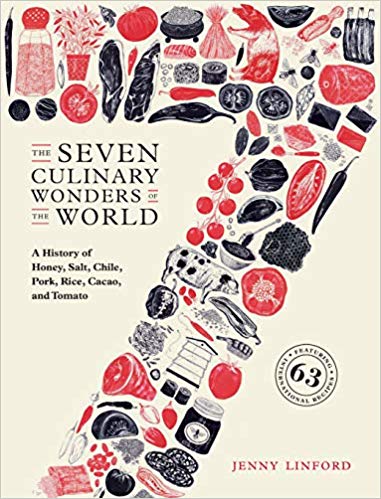
The Seven Culinary Wonders of the World: A History of Honey, Salt, Chile, Pork, Cacao, and Tomato
Tom Verde
Jenny Linford
2018, Smithsonian Books, 9-781-58834-6-421, $27.95 hb.
Humankind’s relationship with the seven ingredients so diligently and informatively explored in this cookbook is “a long one, developed over thousands of years,” to the extent that they “have acquired cultural and religious values.” With these pedigrees in mind, food writer Jenny Linford reaches back into the histories of each ingredient, advising that none should be taken for granted. Images of honey-gathering adorn caves in Valencia, Spain, occupied in prehistoric times, as well as the walls of temples in Egypt where “we come across the first records of beekeeping or apiculture.” Those same Egyptians relied on salt “medicinally to dry out and disinfect wounds.” Rice had a long journey from India and China, reaching the Middle East around 1000 BCE, and was introduced to Europe by Arabs through southern Spain. It forms the foundation of Middle Eastern mejadra (rice and lentils), one of 62 recipes in this thoughtfully curated culinary history.
You may also be interested in...

Untold Stories of British Muslim Women as Agents of Change
Sociologist Sariya Cheruvallil-Contractor and historian Jamie Gilham present 100 years of Muslim women who have contributed to the dynamism of Islam in Britain.
Book Deconstructs Myth Surrounding Egypt’s Most-Famous Boy King
Egyptologist Aidan Dodson sifts the evidence—from tomb paintings to statuary to temple inscriptions—in his quest to recover the real King Tutankhamun.
Children’s Book Documents Rise of Umm Kulthum, Egypt’s Star of the East, As Declaration of National Identity
Illustrator Rhonda Roumani presents an illustrative biography of legendary Egyptian singer and cultural icon Umm Kulthum.